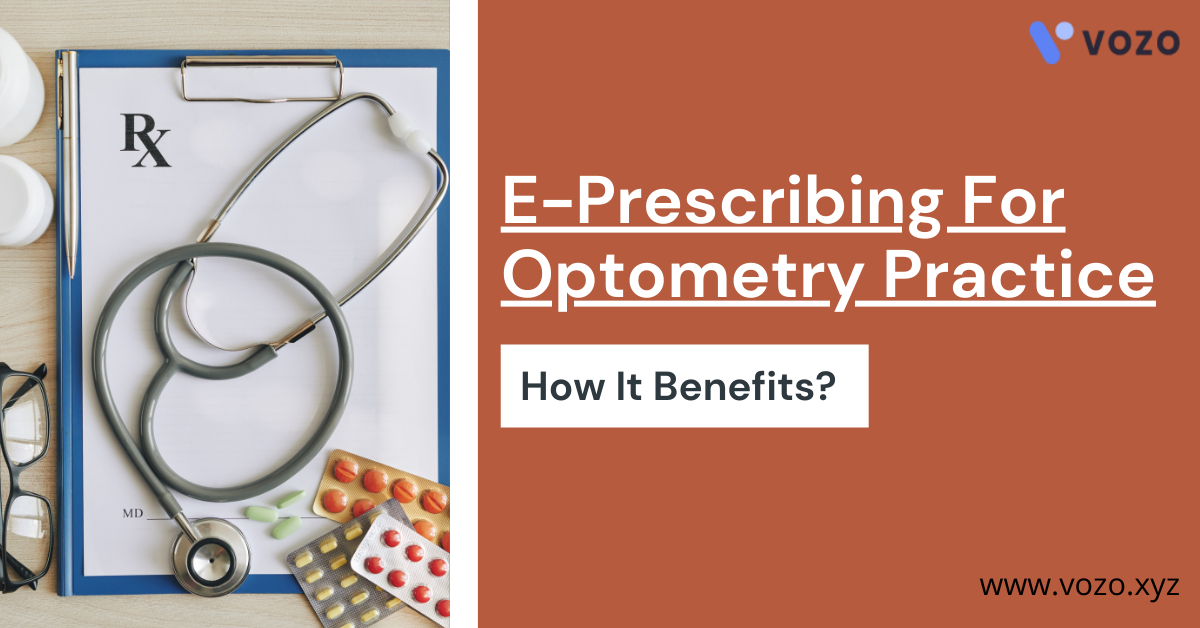E-Prescribing For Optometry Practice: How It Benefits?
E-prescribing, the electronic transmission of the prescription from the point of care to the pharmacy using EHR or e-prescribing software – is the best tool for every optometry practice.
The Centers for Medicare and Medicaid Services (CMS) define a qualified e-prescribing system as one that
- Electronically transmits prescriptions
- Provides warnings about potential allergic reactions
- Provides information about generic medication alternatives
In an increasing number of states, e-prescribing is required for providers who prescribe controlled substances; some states now require providers to use e-prescribing for all prescriptions. e-Prescribing of controlled substances (EPCS) will soon be required for all providers who are prescribing controlled substances covered by Medicare Advantage or Medicare Part D.
EPCS regulations have been put in place to help control the growing epidemic of opioid misuse, abuse, and diversion. One goal of EPCS has been to make it easier to identify patients who might be “doctor shopping.” However, e-prescribing’s benefits reach far beyond regulating controlled substance prescriptions. Here is how e-prescribing benefits your practice.
1. Improve patient safety
Perhaps the most important reason to add e-prescribing to your optometry practice workflow is that it allows you to treat your patients more safely.
Thousands of patients are hospitalized every year due to medication errors and medication-related problems. e-Prescribing helps keep patients safer by eliminating the majority of prescription errors. When pharmacists don’t have to decipher handwritten prescriptions, your office will receive fewer calls from the pharmacy for clarifications. Mistakes will also become less likely, so fewer prescriptions will be filled incorrectly.
e-Prescribing helps prevent other types of errors, as well. The e-prescribing application generates a list of the patient’s active medications and then provides warnings for;
- Possible drug-drug interactions
- Possible drug-allergy interactions
- Duplicate therapy alerts
- Potential dosage problems
With increased accuracy and context-specific warnings, e-prescribing enables you to deliver medications to your patients in an efficient and safer manner while increasing patient safety.
RELATED: E-Prescribing:Top 5 Benefits For Small Practices
2. Write and deliver prescriptions more conveniently
The second reason to add e-prescribing to your workflow is that it will allow you to operate your optometry practice more smoothly and efficiently.
With e-prescribing, you can write and submit secure, regulatory-compliant, digitally signed electronic prescriptions from any desktop computer, laptop computer, or mobile device. e-Prescribing eliminates time you and your office staff have to spend on the phone with the pharmacy for prescription clarifications or to set up refills.
e-Prescribing also allows you to handle Prior Authorizations (PAs) more smoothly and effectively. e-Prescribing gives you immediate access to a patient’s pharmacy benefit formulary information, so you know if a PA will be required while the patient is still at the point-of-care.
Then e-prescribing enables you to submit PA forms electronically, from within your e-prescribing workflow, avoiding paper, fax, and phone authorization requests. You can also respond immediately to electronic PA requests when initiated by the pharmacy after an insurance claim rejection.
By enabling electronic PAs, e-prescribing reduces wait times for insurance approvals, plus lets you and your staff spend less time on the phone discussing PAs with pharmacies and insurance companies.
RELATED: How To Boost Patient Engagement At Your Practice?
3. Improve medication adherence rates
Another benefit e-prescribing brings to your optometry practice is that it’s a research-backed method for improving your patients’ rates of medication adherence.
Taking medication as prescribed is important for controlling both chronic and temporary conditions. However, a study from the U.S. Food and Drug Administration (FDA) reported that 25% of new prescriptions are never filled or picked up by patients. Another study showed that patients fail to take their prescription medications as prescribed at least 50% of the time.
On the other hand, medication adherence is clearly correlated with improved patient outcomes. For instance, researchers in one study found that glaucoma patients who consistently took their prescribed glaucoma medications were less likely to experience glaucoma-induced vision loss.
There are numerous reasons patients fail to take their medications, such as:
- Economic—the prescription costs too much
- Clinical—the patient doesn’t fully understand the medication, its purpose, or its side effects
- Behavioral—the patient doesn’t fully understand how to take the medication or forgets to take it
e-Prescribing can help overcome many of these obstacles. First, e-prescribing provides access to information about whether specific medications are covered under a patient’s formulary, helping you to prevent potential cost issues.
If a medication is not covered for the patient, you are able to view and discuss alternatives while the patient is still at the point-of-care. You also have access to the patient’s out-of-pocket cost for each medication, allowing you to discuss costs and possible alternatives before the patient is possibly confronted by a high price tag at the pharmacy.
Second, studies show that engaging patients at the right time with medication adherence support can reduce prescription abandonment by up to 20%. e-Prescribing can also provide you with educational materials to help you help your patient understand their prescribed medication, its importance, and how to take it.
e-Prescribing to improve your optometry practice
Vozo EHR with e-prescribing feature will help you to stay on the top of advanced prescribing requirements also saving your practice cost and money. Even more important, it will help you provide safer, higher quality care for your patients.
About the author

With more than 4 years of experience in the dynamic healthcare technology landscape, Sid specializes in crafting compelling content on topics including EHR/EMR, patient portals, healthcare automation, remote patient monitoring, and health information exchange. His expertise lies in translating cutting-edge innovations and intricate topics into engaging narratives that resonate with diverse audiences.













